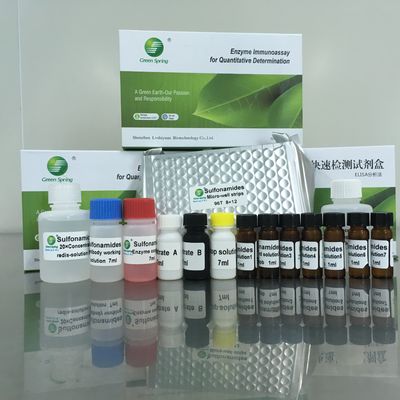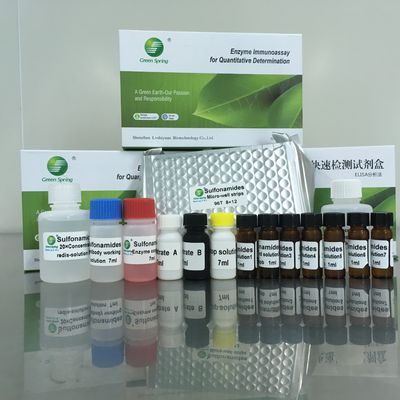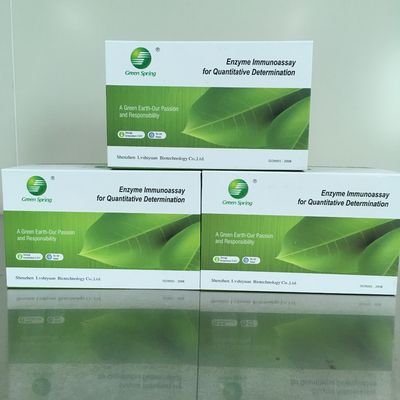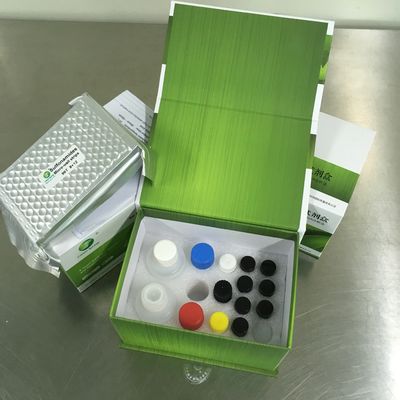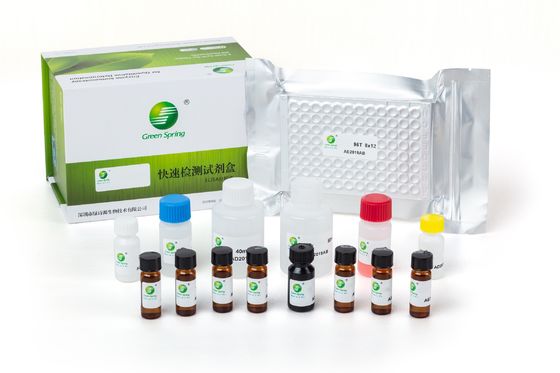|
|
LSY-10056 Colistin ELISA Test Kit for tissue, egg, milk and feed detecting
Product Details:
Payment & Shipping Terms:
|
| Properties: | Diagnosis & Injection | Specifications: | 96 Wells/kit |
|---|---|---|---|
| Sensitivity: | 1.5 Ppb | Sample Performance: | Tissue, Egg, Milk And Feed |
| Shelf Life: | 12 Months When Properly Stored | Recovery Rate: | 90±30% |
Colistin ELISA Test Kit
Catalog No. LSY-10056
1. Principle
This test kit is based on the competitive enzyme immunoassay for the detection of Colistin in the sample. The coupling antigens are pre-coated on the micro-well stripes. The Colistin in the sample and the coupling antigens pre-coated on the micro-well stripes compete for the anti-Colistin antibodies. After the addition of the enzyme conjugate, the TMB substrate is added for coloration. The optical density (OD) value of the sample has a negative correlation with the Colistin in it. This value is compared to the standard curve and the Colistin concentration is subsequently obtained.
2. Technical specifications
Sensitivity: 1.5ppb
Detection limit
Tissue about 50ppb
Raw milk about 60ppb
Finished milk about 45ppb
Feed about 150ppb
Note: ppb= ng/ml or ng/g
Cross-reaction rate
Colistin 100%
Recovery rate
90±30%
3. Components
- Micro-well strips: 12 strips with 8 removable wells each
- 6× standard solution (1mL each): 0ppb, 1.5ppb, 4.5ppb, 13.5ppb, 40.5ppb
- 11X Concentrated Enzyme conjugate (0.7 mL)
- Enzyme conjugate dilution (7 mL)
- Substrate A (7 mL)
- Substrate B (7 mL)
- Stop solution (7 mL)
- 20× concentrated washing buffer (30 mL)
- Redissolving solution (50 mL)
4. Materials required but not provided
- Equipments: microplate reader (450nm, 630nm), printer, homogenizer, nitrogen-drying device, vortex, shaker, centrifuge (4000g and above), measuring pipets, balance (a reciprocal sensibility of 0.01 g), incubator (25℃), timer;
- Micropipettors: single-channel 20-200 µL, 100-1000 µL, and eight-channel 30~300 µl;
- Reagents (AR): Deionized water, HCl, H2SO4, Methanol, NaCl.
5. Sample pre-treatment
Instructions
The following points must be dealt with before the pre-treatment of any kind of sample:
- Only the disposable tips can be used for the experiments and the tips must be changed when used for absorbing different reagents;
- Before the experiment, each experimental equipment must be clean and should be re-cleaned if necessary, in order to avoid the contamination that interferes with the experimental results.
Solution preparation before sample pre-treatment:
- Tissue sample extracting solution: Take 5ml HCl, add into container with 115ml deionized water, then add 7.5g NaCl, dissolve and mix them completely.
- Milk sample extracting solution: Take 2.8ml 98.3%H2SO4, add into 250ml deionized water, mix them evenly.
- Washing buffer: 1 part 20× concentrated washing buffer + 19 parts deionized water.
5.1 Samples preparation
a) Tissue (Chicken, duck)
1) Weigh 1.0g±0.05g of the homogenized sample (tissue) into 50ml plastic centrifuge tube; Add 1ml Tissue sample extracting solution and 2ml Methanol, use vortex for 2min, Centrifuge at above 3000 g at room temperature for 5min(Note: Vortex immediately after adding extracting solution and methanol to avoid sample agglomeration);
2) Take 50ul up-layer liquid, add 450ul Redissolving solution, use vortex for 20s;
3) Take 50ul liquid to test.
Fold of dilution of the sample: 40
b) Raw milk, finished milk
1) Weigh 1ml milk sample into 4ml plastic centrifuge tube; Add 1ml Milk sample extracting solution and 1ml Methanol, use vortex for 1min;
2) Centrifuge at above 3000 g at room temperature for 5min;
3) Avoid up-layer suspension,take 50ul up-layer clear liquid, add 450ul Redissolving solution, use vortex for 20s;
3) Take 50ul liquid to test.
Fold of dilution of the sample: 30
c) Feed
1) Weigh 1g feed sample into 10ml plastic centrifuge tube; Add 2ml Milk sample extracting solution and 2ml Methanol, use vortex for 1min;
2) Centrifuge at above 3000 g at room temperature for 5min;
3) Take 50ul up-layer clear liquid, add 450ul Redissolving solution, use vortex for 20s;
3) Take 50ul liquid to test.
Fold of dilution of the sample: 80
6. ELISA procedures
6.1 Instructions
1) Bring all reagents and micro-well strips to the room temperature (20-25 ℃) before use;
2) Return all reagents to 2-8 ℃ immediately after use;
3) The reproducibility of the ELISA analysis, to a large degree, depends on the consistency of plate washing. The correct operation of plate washing is the key point in ELISA the procedures;
4) For the incubation at constant temperatures, all the samples and reagents must avoid light exposure, and each microplate should be sealed by the cover membrane.
6.2 Operation procedures
- Take out all the necessary reagents from the kit and place at the room temperature (20 to 25 ℃) for at least 30 minutes. Note that each liquid reagent must be shaken to mix evenly before use.
- Enzyme conjugate preparation: take 1 part 11X Concentrated Enzyme conjugate, add 10 parts Enzyme conjugate dilution, dilute at 1:10.
- Take the required micro-well strips and plate frames. Re-sealed the unused microplate, stored at 2-8 ℃, not frozen.
- Numbering: number the micro-wells according to samples and standard solution; each sample and standard solution should be performed in duplicate; record their positions.
- Add 50µL of the sample or standard solution to separate duplicate wells, then add enzyme conjugate, 50 µL each well. Mix gently by shaking the plate manually, seal the microplate with the cover membrane, and incubate at 25 ℃ at dark for 30 minutes.
- Pour liquid out of microwell, add 250 µL/well of washing buffer for 15-30 seconds, repeat three to four times, then flap to dry (if there are bubbles after flapping, cut them with the clean tips).
- Coloration: add 100 µL mixture of the substrate A and substrate B into each well (Note: mix Substrate A and Substrate B at 1:1, the mixture should be used in 10min, never use metal container or metal to stir the solution, otherwise the substrate may be invalid.). Mix gently by shaking the plate manually, and incubate at 25 ℃ for 15-20 minutes at dark for coloration.
- Determination: add 50 µL of the stop solution into each well (The substrate color from blue to yellow, it means the stop succeeds). Mix gently by shaking the plate manually. Set the wavelength of the microplate reader at 450 nm to determine the OD value (Recommend to read the OD value at the dual-wavelength 450/630 nm within 5 minutes).
7. Result judgment
There are two methods to judge the results: the first one is the rough judgment, while the second is the quantitative determination. Note that the OD value of the sample has a negative correlation with the Colistin concentration.
7.1 Qualitative determination
The concentration range (ng/mL) of Colistin can be obtained from comparing the average OD value of the sample with that of the standard solution. Assuming that the OD value of the sampleⅠ is 0.3, and that of the sampleⅡ is 1.0, the OD value of standard solutions is: 2.243 for 0ppb, 1.816 for 0.5ppb, 1.415 for 1.5ppb, 0.74 for 4.5ppb, 0.313 for 13.5ppb, 0.155 for 40.5ppb, accordingly the concentration range of the sampleⅠ is 13.5 to 40.5ppb, and that of the sampleⅡ is 0.5 to 4.5ppb.
7.2 Quantitative determination
The mean values of the absorbance values is obtained for the average OD value (B) of the sample and the standard solution divided by the OD value (B0) of the first standard solution (0 standard) and subsequently multiplied by 100%, that is,
| Percentage of absorbance value = | B | ×100% |
| B0 |
B—the average OD value of the sample or the standard solution
B0—the average OD value of the 0 ng/mL standard solution
Draw the standard curve with the absorption percentages of the standard solution and the semilogarithm values of the Colistin standard solution (ng/mL) as Y- and X-axis, respectively. Read the corresponding concentration of the sample from the standard curve by incorporating its absorption percentage into the standard curve. The resulting value is subsequently multiplied by the corresponding dilution fold, finally obtaining the Colistin concentration in the sample.
8.Precautions
1) Read the manual carefully before use;
2) Return all reagents in the kit to room temperature(25±2℃) (about 1 hour) before use;
3) Shake the reagent evenly before use, avoid bubbles when mixing;
4) The tips are disposable, to avoid cross-pollution, do not repeat use the tips;
5) Do not use test kits out of date, do not mix use reagents from different batch;
6) Test the sample immediately after sample preparation, otherwise it may affect results;
7) The substrate A and substrate B are both colorless and transparent liquids. If they become blue before use, or turn blue immediately after mixing, the reagents are contaminated or deteriorated.
8) Sampling process must be rapid on the premise of ensuring accuracy, so as to avoid the influence of reaction time difference on the test results.
9) The stop solution contains sulfuric acid. If you accidentally splash on your skin or clothing, rinse immediately with plenty of water. If you accidentally get into the eyes, please go to the hospital for examination after thorough cleaning.
9. Storage and expiry date
Storage: store at 2-8 ℃, not frozen.
Expiry date: 12 months; date of production is on box.
![]()
elisa kit
-
LSY-10049 Chlortetracyline ELISA test kit Antibiotic detection
-
LSY-10050 Erythromycin ELISA test kit for milk, honey, tissue
-
LSY-10046 MQCA Olaquindox metabolites ELISA Test Kit ISO certificated
-
LSY-10047 Nitroimidazoles ELISA Test Kit for tissue, honey, milk and egg
-
LSY-10047 Nitromidazoly ELISA Test Kit antibiotic residue Food safety
-
LSY-10047 Nitromidazoly ELISA Test Kit Food testing ISO certificated



